When people think of Nevada they tend to visualize a Hollywood desert but the reality is quite a bit different. Yes, there are desert areas, but you’ve also got mountains, rivers, grassy valleys, and lakes. In short, you’ve got a lot of different environments for a pretty diverse collection of birds! Today we are going to talk about the popular backyard birds of Nevada and give you some information which you can use to identify, lure, or locate these beautiful creatures. Let’s talk about those backyard birds of the Sagebrush state!
3 Categories – 396 Birds
Nevada is the full or part-time home of an impressive 396+ Avian species. This is certainly enough to keep any birder busy and while we’d love to tell you about all of the birds here we’re going to have to bow to space-concerns and give you a sampling. We’ll divide the birds like this:
- Year-round Resident birds
- Birds of Spring, Summer, and Early Fall
- Fall and Winter Birds
We’ll provide you with some useful information when it comes to luring these birds to your feeder or finding out in the wild. While we cannot guarantee that the desired bird will come we can definitely help you to hedge your bets. We’ll get the ball rolling with Nevada’s year-round resident birds.
Nevada’s Year-round Resident birds
These birds may be found in the state of Nevada at any time of the year provided that you keep an eye out and a full feeder as backup. See if you can spot one of these birds this year:
- American Robin
- Mourning Dove
- Northern Flicker
- Say’s Phoebe
- Yellow-rumped Warbler
American Robin – Turdus migratorius
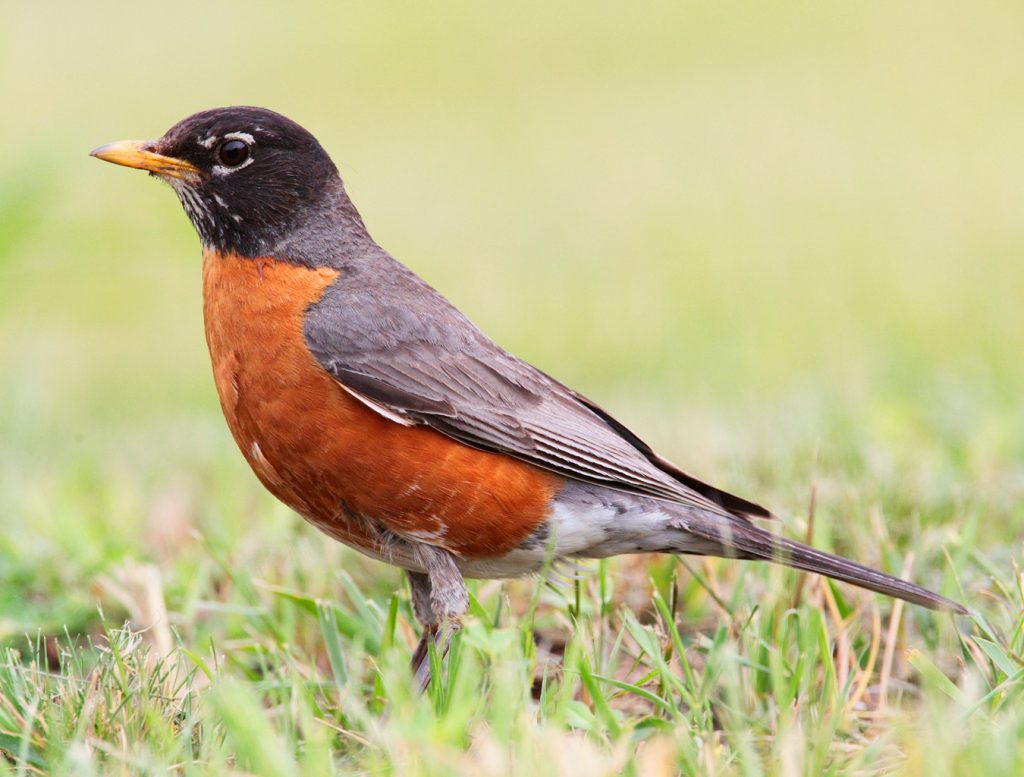
Coloration and Markings: American Robins have grayish-brown backs with medium-length wings and long tails of the same color, though the tails will be white on the undersides. The rump of this bird is white but the underbelly and breast are a dark, tangerine orange. Facially, this bird has a black head with a medium-length, slightly curved yellow bill as well as a distinctive eyering which looks as if it were broken into pieces.
Size: These birds measure in at 7.9 – 11 inches from head to tail and have wingspans of 12.2 to 15.6 inches wide.
Habitat: Robins are bold birds that get around, so look for them in places like parks, fields, golf courses, or even the snow as they forage for their next meal. They are happy to visit a well-stocked feeder, just leave out something which you know that they will like.
Diet: Suet, crushed peanuts, and raisins are an easy-to-provide set of foods that are all considered fine dining by the American Robin.
Mourning Dove – Zenaida macroura
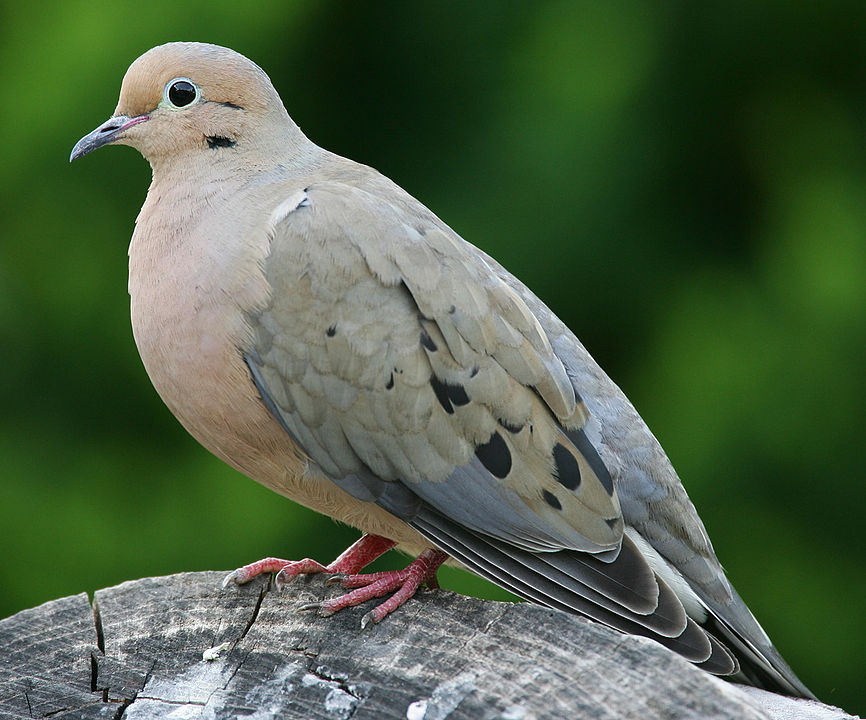
Coloration and Markings: Mourning Doves have gray backs with medium-length gray wings and long, gray, and distinctively pointy tails. The wings have a heavy concentration of tan coloration along with large, black spots, and the underbelly and breast of this bird have a creamy tan color to them, with some white often present just under the wings. Facially, these birds have more tan color concentrated and you’ll also notice a lovely white eyering. These birds have straight, medium-length black bills.
Size: These birds measure 9.1 = 13.4 inches in length and have wingspans of approximately 17.7 inches in width.
Habitat: Mourning Doves don’t like going deep into the woods, preferring instead to do their foraging in parks, farms feeders, and all over the city. Be sure to leave out something in your feeder and you might just make a new friend!
Diet: White Proso millet and cracked corn are both favorites of the Mourning Dove. Put them out separately or mixed and see what happens… you’ll be happy that you did!
Northern Flicker – Colaptes auratus
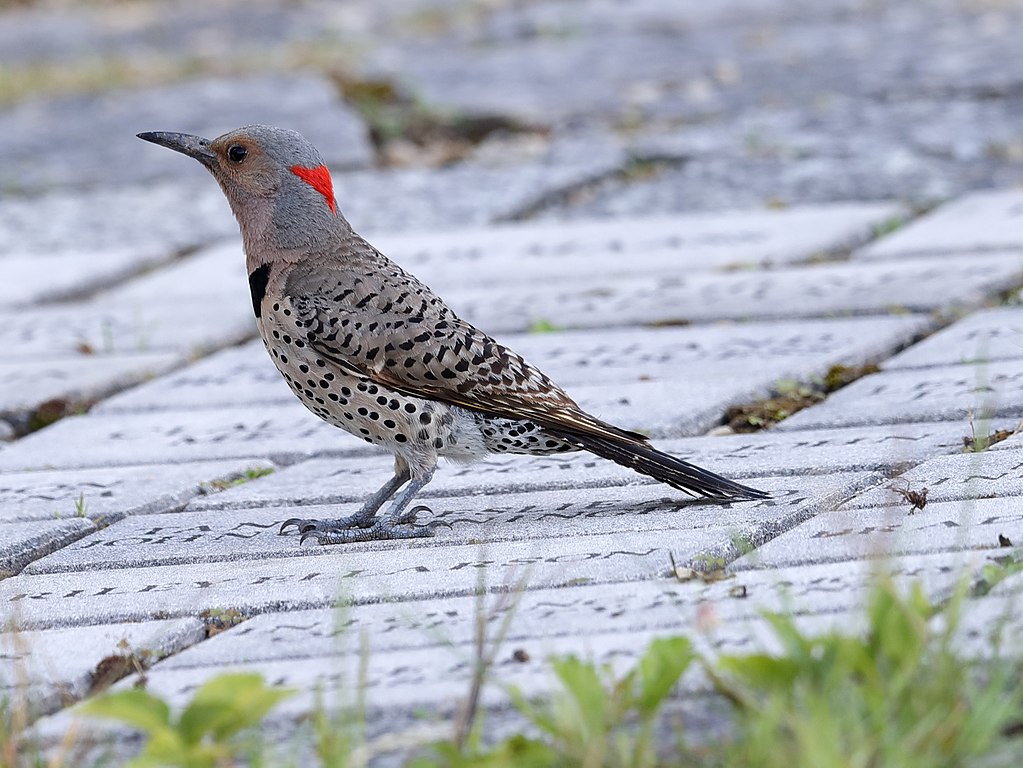
Coloration and Markings: Northern Flickers have grayish-brown backs with medium-length gray wings which are decorated with black spots and crescents. They also have long, flared tails, which will be grayish-brown on top and bright yellow or foxy red on the undersides. The underbelly and breast of this bird are gray and tan with spots and with a large crescent mark at the top of the breast. Facially, these birds have a gray head with a red stripe across the cheek coming from the lower bill as well as a brown eyestripe and a thin, white eyering. These birds have long, slightly curved bills.
Size: These birds measure in at 11 – 12.2 inches from tip to tail and have wingspans of 16.5 to 20.1 inches wide.
Habitat: These birds love open areas, especially in the mountains. You can find them at the forest’s edge, parks, and backyards as well, so don’t forget to leave something out. These are amazing looking birds and you won’t want to miss out!
Diet: Mealworms, Black Oil Sunflower seeds, and whatever fruits that you have on hand are all acceptably yummy meals for the Northern Flicker and might just earn you a feeder visit!
Say’s Phoebe – Sayornis saya

Coloration and Markings: Say’s Phoebe has a grayish-brown back with medium-length, gray wings and a long, gray tail. The underbelly and breast of this bird are a reddish-brown color, with a heavy mixing of gray occurring higher up on the breast. Facially, these birds are gray with medium-length, straight black bills.
Size: These birds measure in at approximately 6.7 inches from head to tail and have wingspans around 13 inches in width.
Habitat: These birds like dry, open areas, shying away from water and spending their time in desert, canyon, or areas with a little dry brush cover.
Diet: These birds won’t generally visit a feeder but you might have a little luck with some mealworms placed in an open area with high-visibility.
Yellow-rumped Warbler – Setophaga coronata

Coloration and Markings: Male Yellow-rumped Warblers have gray backs with short, gray wings and long, gray tails. The wings are marked with broad, vertical white stripes and the tails are white underneath and have black in the corners. The underbelly and breast of this bird are white with a flanking of black spots which thickens and solidifies at the top of the breast. Facially, this bird has a gray face, with part of a white, curved-eyering above and below the eye and you will also notice distinctive yellow patches at the chin and throat, under the wings at the shoulders, and at the top of the head. Females have a more dimmed coloration and may display some brown and in the winter, both genders will be light brown with some telltale yellow dim, but present.
Size: These little birds measure in at 4.7 – 5.5 inches in length and have wingspans of 7.5 to 9.1 inches.
Habitat: When it’s warm, these Warblers prefer coniferous woods, especially open areas such as meadows or the forest’s edge. They will settle for deciduous areas if they can’t find a coniferous region, however, and you can also find them at the coast, parks, or backyards as long as there is a little cover in the form of brush, brambles, or briars.
Diet: Suet, hulled Black Oil Sunflower seeds, and mealworms are all foods which can attract the Yellow-Rumped Warbler.
Nevada’s Birds of Spring, Summer, and Early Fall
Mexican plum trees are blooming, almond blossoms fall, and the Red Spraxis is making itself visible for all to see. Signs like this indicate that spring has arrived and with it will be a number of birds just waiting for you to spot them. They’ll only be around for a few months, so see if you can spot one of these birds during the warmer months:
- Red-Winged Blackbird
- Scott’s Oriole
- Hooded Warbler
- Lucy’s Warbler
- Red-naped Sapsucker
Red-Winged Blackbird – Agelaius phoeniceus

Coloration and Markings: Red-Winged Blackbirds have some lovely plumage going for them. While they are black all over, their backs and inner-wing display a lovely assortment of red and yellow lines, which look as if they were stitched there in fine, colored threads. They have long, black wings, with red and yellow marks on their shoulder which look rather like a red shark fin swimming in a yellow-stripe sea when the bird is at rest. Facially, these birds have rather distinctive large, pointy conical bills.
Size: Roughly Robin-sized, these birds measure in at 6.7 – 9.1 inches in length and have wingspans of 12.2 to 15.8 inches wide.
Habitat: These birds love water, so look for them around ponds, marshes, or even at water-traps in golf courses. That said, you can still find them in dry, overgrown fields and feedlots but around the water is a much more common place to find them.
Diet: Suet, Black Oil Sunflower seeds, and shelled peanuts are a treat for the Red-winged Blackbird and might just earn you a visit!
Scott’s Oriole – Icterus parisorum

Coloration and Markings: Scott’s Oriole males have black backs with medium-length black wings, which sport 2 white wingbars on each. They have long, black tails with some yellow above and below as the color approaches the yellow rump. The underbelly and breast of this bird are both yellow with some black v’ing in from the face and throat of the bird and some of the yellow from the breast spreads in to the tops of the shoulders. Facially, these birds have black faces with long, slightly curved black bills which often show a little blue on the lower bill close to the face. Females have more muted yellows and are olive green instead of black while juvenile males will have a mix of the colorations of both.
Size: These birds measure in at approximately 9.1 inches from tip to tail and have wingspans averaging 12.6 inches in length.
Habitat: These Orioles tend to spend time in the desert or lower regions of the mountains, look for them near yuccas, junipers, and pinyon pines and you can sometimes find them in chaparall cover or near mesquite trees.
Diet: Skip the seeds as you are more likely to lure this bird with orange-halves, grape jelly, and live mealworms. Any or all of these will suffice for the Scott’s Oriole.
Hooded Warbler – Setophaga citrina
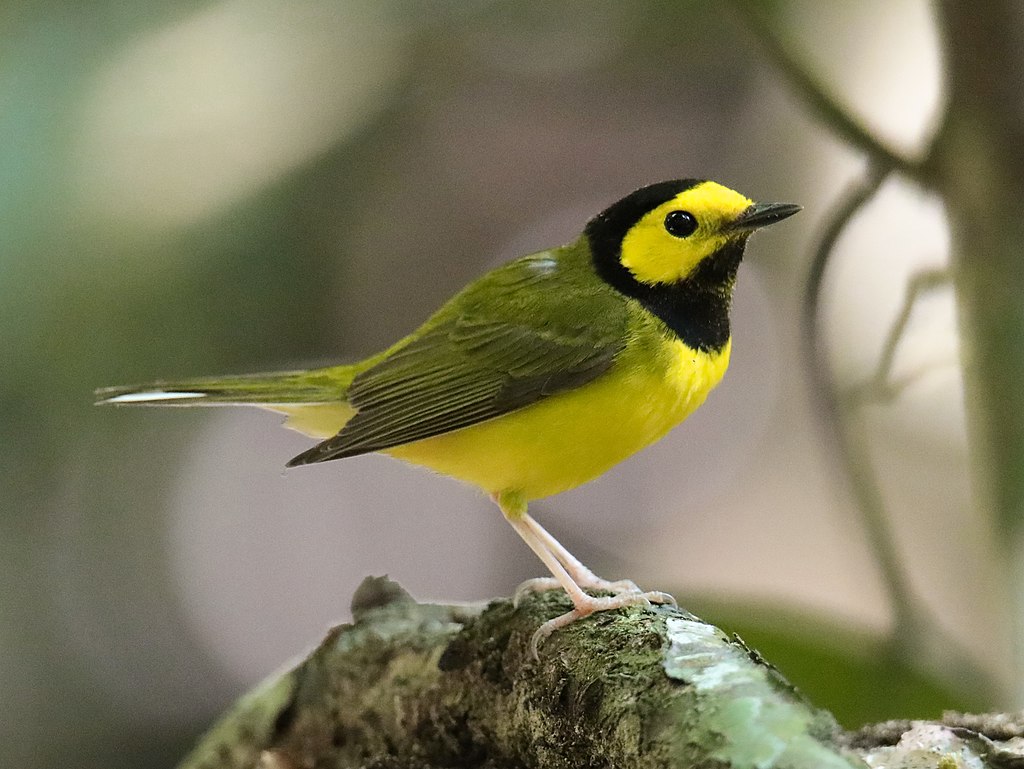
Coloration and Markings: Male Hooded Warblers have gray and olive-green (or sometimes green and yellow) backs with short wings and long tails of the same color. White outer feathers are present on the tail but hard to see when the bird is not in flight. The underbelly and breast of this bird are bright yellow and facially, this bird has a black head and throat with a large, bright yellow mask. It looks as if the bird is wearing a black hood. Females and juveniles will lack the hood, though in rare cases you may see the outline of it on some adult females. These birds have thin, medium length black bills.
Size: These birds measure approximately 5.1 inches from tip to tail and have wingspans averaging 6.9 inches wide.
Habitat: When it is warm these Warblers are generally found deep in deciduous woods, in areas where the shrub and brush cover are present and dense. You can find them in other locations but the shrub cover needs to be there for this bird to forage in confidence.
Diet: Suet and Black Oil Sunflower seeds are great choices when looking to attract the Hooded Warbler.
Lucy’s Warbler – Leiothlypis luciae

Coloration and Markings: Lucy’s Warblers are mostly gray, with gray backs, medium-length gray wings, and short, perky gray tails. They have brownish-red rumps and the underbelly and breast of this bird will be a mix of whites and grays, the color of which carries up to the throat and the chin and is also frames the eyes. The remainder of the face is gray and these birds have thin, straight, and medium-length grayish-black or dirty orange bills. Females and juveniles will have more muted coloration and their rump-color will be yellowish with a mix of red or brown.
Size: These little guys and gals measure in at 3.5 – 4.7 inches in length, with wingspans just around 7 inches in width.
Habitat: These Warblers don’t stick out much by appearance but as far as habitat, they are the only Warblers that are quite at home in the desert. Look for them there around desert stands, especially acacia or mesquite. They are also comfortable in open, wooded areas at higher elevations.
Diet: These birds primarily eat insects and will likely not visit your feeders, though you can try leaving out some live mealworms where they can be seen and you might just get lucky.
Red-naped Sapsucker – Sphyrapicus nuchalis

Coloration and Markings: Red-naped Sapsuckers have black backs with some white mixed in, as well as long, black and white wings and short, stiff tails of the same color. The underbelly and breast of this bird are white with a heavy flanking of dim black and white that looks almost like mottled-stripes and increases in density as it approaches the breast. Facially, this bird has a red chin and throat and a mostly white face, excepting a thin, black stripe just under the cap, a thicker black eyestripe, and a black mustache line. Females will have white chins, instead of red, and juveniles will have a brown cap and touches of brown are often present on the face and the belly as well. These birds have long, straight, and pointy black bills.
Size: These birds measure in at 7.5 – 8.3 inches in length and have wingspans of 16.1 to 16.9 inches wide.
Habitat: When it is warm, look for them in woods where birch, juniper, and aspens are plentiful. In the winter you are more likely to find them around oaks and pines and they also do a bit more ranging into places like orchards or open areas near streams.
Diet: Suet, chunky peanut butter, and whatever fruits you can find are welcome-offerings as far as the Red-naped Sapsucker is concerned.
Nevada’s Fall and Winter Birds
Day lows are not so bad at around 41 degrees but at night it’s a different story, where Nevada winter chill can be as low as 12 degrees. A number of birds are still out there, toughing out the cold and they could certainly use a little extra suet or even a heated birdbath if you’ve got one. Try and help one of these birds out this winter, if you can. There birds will certainly appreciate your support:
- Rock Pigeon
- European Starling
- Dark-eyed Junco
- Horned Lark
- Blue-headed Vireo
Rock Pigeon – Columba livia
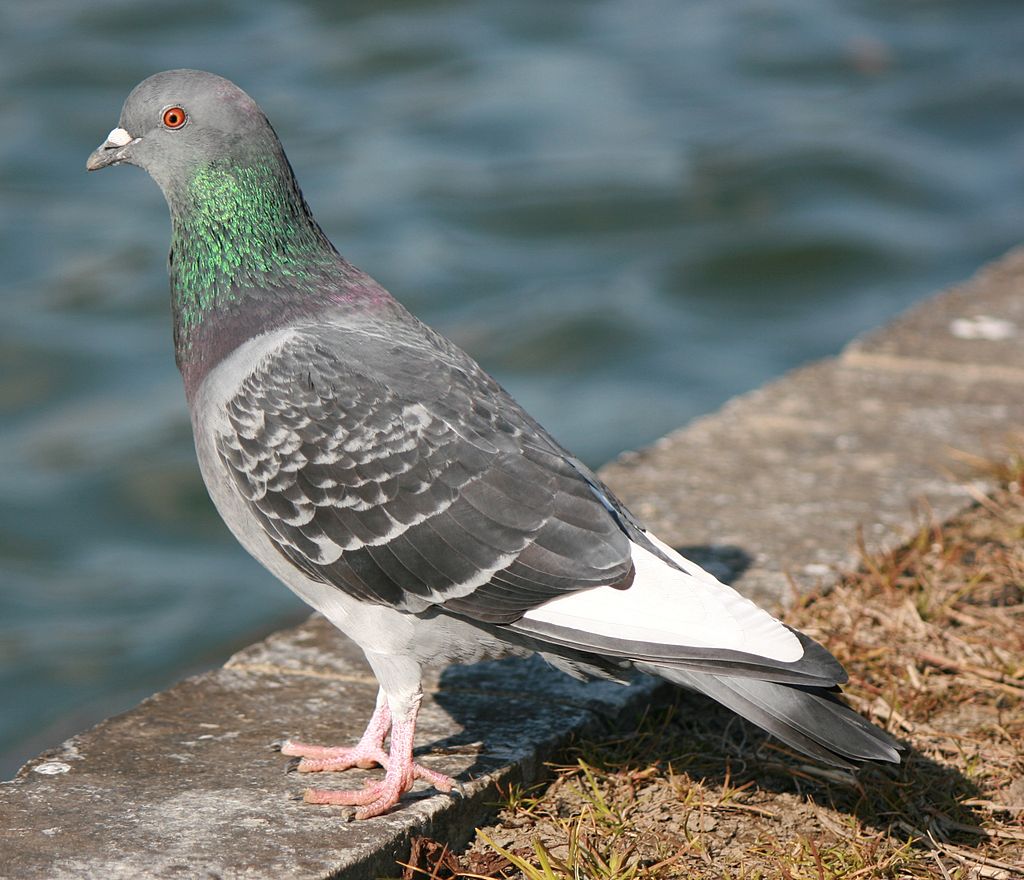
Coloration and Markings: Rock Pigeons are mostly gray, although some will present a lot of white mixed in and there are a number of regional differences. Most commonly, this bird have a gray back, with long gray or white and gray wings with two dark wingbars also be present. They have short, rounded tails, often dark at the tips, and the underbelly and breast of this bird are a light gray color. They have long necks, with a swathe of purple or bluish green on the neck and facially, these birds are light gray with short, slightly curved black bills.
Size: These birds measure in at 11.8 – 14.2 inches from head to tail and have wingspans of 19.7 to 26.4 inches wide.
Habitat: These Pigeons don’t spend time in the woods, preferring cities, farms, and fields when they are not spending time in Cliffside areas.
Diet: Black Oil Sunflower seeds, wheat, and rolled oats are all excellent choices for attracting a Rock pigeon to your feeder.
European Starling – Sturnus vulgaris
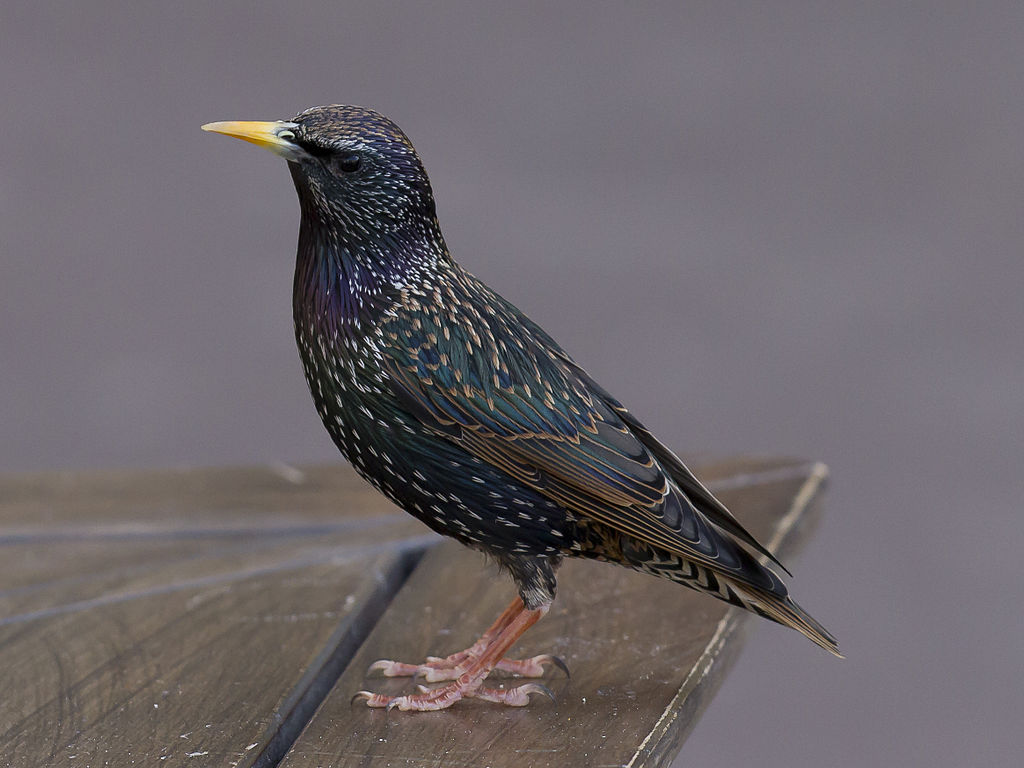
Coloration and Markings: European Starlings have purplish-green plumage all over their bodies. They have long wings and short tails and facially, they have long, straight, and thick yellow bills. In the winter these birds change colors, molting into brown plumage with beautiful white spots.
Size: Roughly Robin-sized, these birds measure in at 7.9 – 9.1 inches in length and have wingspans measuring 12.2 to 15.8 inches wide.
Habitat: These birds eschew the woods for more productive foraging environments, specifically those inhabited by humans. You can find them at farms or scattered around the city as they look for their next meals.
Diet: Peanuts, Black Oil Sunflower seeds, and fresh fruits are all favorites of Starlings. They will eat all of your suet as well, so consider a Starling-proof feeder if they aren’t leaving any for the rest of the birds.
Dark-eyed Junco – Junco hyemalis

Coloration and Markings: While Dark-eyed Juncos have a number of regional variations, typically they will have a dark brown or gray back, with medium-length gray wings and long, gray tails which will be white on the undersides. The underbelly and breast of this bird are white as well, with a flanking of gray which increases in density as it moves to the breast. The effect is about the same as if the bird had been wading through a puddle of white paint, as it seems to distribute evenly along the bottom when the bird is at rest. Juncos have a gray face and some black may be present going from the upper bill to the front of the eye and these birds have stout, medium-length, conical pink bills.
Size: These birds measure in at 5.5 – 6.3 inches in length and have wingspans of 7.1 to 9.8 inches wide.
Habitat: Juncos prefer coniferous forests when it’s warm, with mixed-coniferous being their second choice if they cannot locate one. You can also find them in fields, parks, and backyards, so be sure to leave a little something out to show them that they are welcome.
Diet: Dark-eyed Juncos will be quite happy to visit your backyard feeder, provided you have left out some favorites such as hulled Black Oil Sunflower seeds, cracked corn, or White Proso millet.
Horned Lark – Eremophila alpestris

Coloration and Markings: Male Horned Larks are plump birds with sandy-brown backs, medium-length sandy wings, and long, sandy to dark brown tails. They have white rumps, but the underbelly and breast of this bird are white with a heavy flanking of gray at the sides and at the top of the breast. Facially, these birds have a yellowish chin and the color extends towards the back of the head. A thin, black line is also present at the base of the throat and this bird has a black mask as well, which passes the eyes and then widens as it curves down over the cheek. Above the eyes and behind the cheek this bird has a light tan coloration and the back and top of the head will be sandy brown. The ‘horns’ of this bird are easy to spot, as there is a black ‘circle’ line at the top of the head which terminates towards the back as tufted ‘horns’. Females will have the same color scheme, just a bit less contrasting, and these birds have short, thin black bills which are aligned straight but show a slight curvature in the shape of the upper bill.
Size: These birds measure in at 6.3 – 7.9 inches in length and have wingspans of 11.8 to 13.4 inches.
Habitat: These Larks loves the land and the barer, the better. They like cleared areas of areas where the vegetation is quite sparse and it’s not uncommon to spot them foraging in the desert or eve the snow!
Diet: Hulled Black Oil Sunflower seeds and Nyjer thistle may attract the attentions of a hungry Horned Lark.
Blue-headed Vireo – Vireo solitarius

Coloration and Markings: Blue-headed Vireos have greenish-gray backs with short wings that are gray with two white wingbars towards the outer portion and a little darker at the inner portions, where you can see some white present creating a ‘scaled’ patter going down the lower back. They have preky, medium-length bluish-gray tails which are white at the edges and the undersides and the underbelly and breast of this bird will be white, with a yellow-green flanking just below the wings. Facially, this bird has a blue-gray face, with a white chin, and white ‘spectacles’ and this bird has a short, straight, and lightly hooked black bill.
Size: These diminutive birds measure in at 4.7 – 5.9 inches in length and have wingspans of 8.7 to 9.5 inches wide.
Habitat: These Vireos are found most often in montane or boreal regions of woods, though in the winter all bets are off and any woods will do – provided that is a good amount of brush cover.
Diet: These birds are fond of insects and small fruits as well, so try leaving out some dry or live mealworms and a nice side of chopped cherries and you might tempt one of these cute little Vireos in for a visit!
Supporting cast (Other Backyard Birds of Nevada that might pay you a visit)
We like to include a bonus cache of year-round birds that you can look for at any time of the year and while they didn’t get the front page, our ‘Supporting cast’ birds are still nothing short of amazing. Keep an eye out for one of these birds at any time of the year:
- House Finch
- White-crowned Sparrow
- Ruby-crowned Kinglet
- Brown Creeper
- Pygmy Nuthatch
House Finch – Haemorhous mexicanus
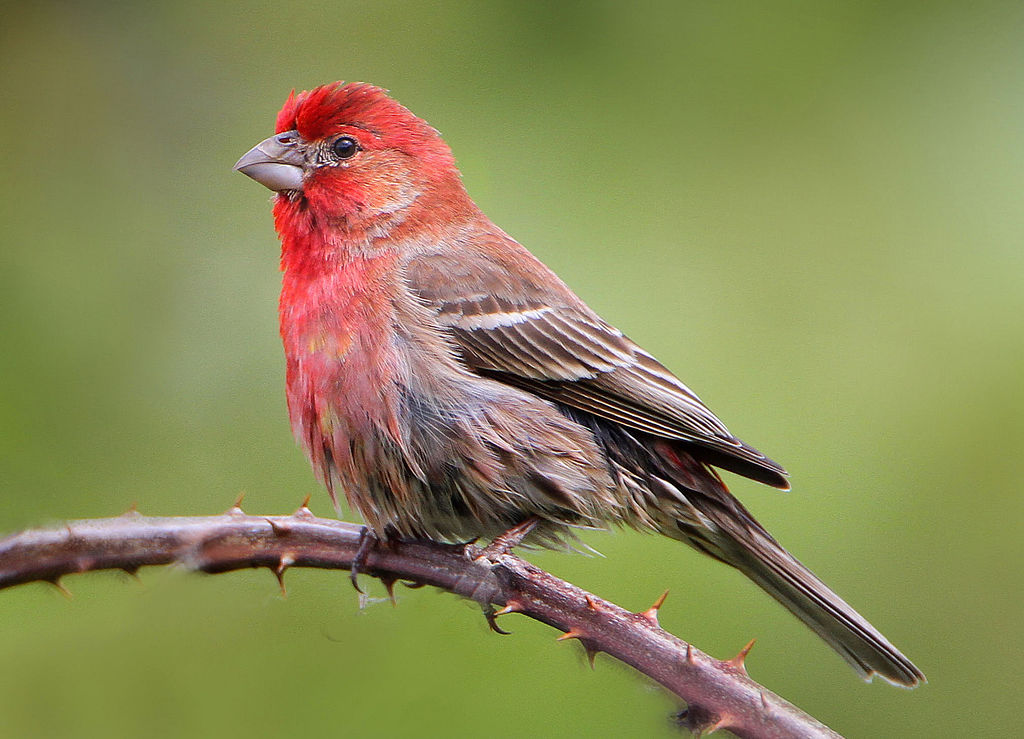
Coloration and Markings: House Finches have gray backs with brown streaking, as well as short, brown to dark-brown streaked gray wings that have 2 white wingbars on each and lonh, perky gray tails with white on the sides and undersides. The underbelly of this bird is white with brown streaks and the breast is white with a heavy saturation of rosy-red color that extends up into the face, with dim traces of brown streaking still present. Facially, these birds are pinkish-red at the chin and cheeks, as well as at the crown of their heads, with the remainder of the face being gray except for a brown eyeline that crosses the eyes and curls down and around to frame the cheek. These birds have stout, medium-length silver bills with a noticeable curve in the upper bill. Females will be brown and gray, lacking the red coloration of the males, and their streaking will be heavier and quite blurred.
Size: These birds measure in at 5.5 – 5.5 inches in length and have wingspans of 7.9 to 9.8 inches wide.
Habitat: These Finches are at home in desert areas, grasslands, the forest’s edge, or even your own backyard.
Diet: Nyjer thistle and White Proso millet are all that you need to keep House Finches happy.
White-crowned Sparrow – Zonotrichia leucophrys

Coloration and Markings: White-crowned Sparrows have brown backs with medium-length brown wings, sometimes exhibiting some black on their feathers in the center of the back and at the edge of the wings but this is not always present. They have long, brown tails where some black may be displayed as well and the underbelly of this bird is white with a flanking of light brown and the overall color turns to gray as it moves up to the breast. These birds have gray necks, chins, and cheeks, and a black mask which is thin and travels through the eyes to the back of the head. A white eyebrow line is present above this, with a black stripe over it and the top-center of the birds head is white. These birds have small, stout, and conical orange bills and juveniles will display brown stripes instead of the black.
Size: These birds measure in at 5.9 – 6.3 inches in length and have wingspans of 8.3 to 9.4 inches wide.
Habitat: Commonly found at the forest’s edge or in alpine meadows, these birds like places with a lot of brush cover such as shrubs, hide weeds, or grass.
Diet: Suet can attract these Sparrows and they also like mealworms –dried or live.
Ruby-crowned Kinglet – Regulus calendula
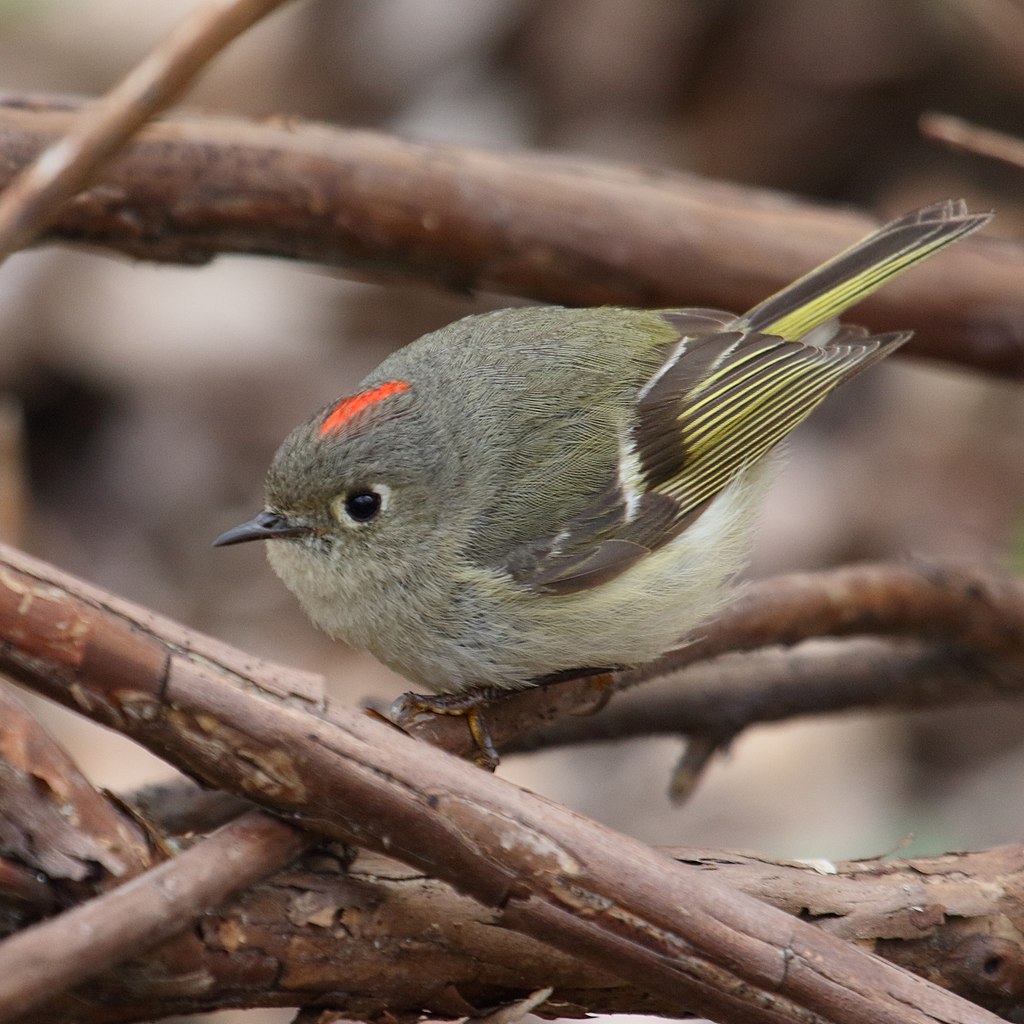
Coloration and Markings: Ruby-crowned Kinglets have soft, gray backs with medium-length, grayish-green wings where you will spot a white wingbar with a larger, black wingbar immediately underneath. They have short, perky gray tails with some yellow-green present on the edges and the underbelly and breast of this bird are white. Facially, this bird is whitish at the chin and base of the throat (or sometimes just a lighter gray) with the remainder of the face being a darker gray with the exception of the white around the eyes, the bright red crown, and the medium-length, straight, and thin black bill.
Size: These birds are tiny, measuring in at just 3.5 – 4.3 inches in length and having wingspans of 6.3 to 7.1 inches wide.
Habitat: These Kinglets like coniferous forest’s when it’s warm and deciduous woods in the winter. That said, as long as there is a good bit of cover in the form of brush, bushes, brambles, or thorns they might just be found nearby.
Diet: While these birds are primarily insectivorous, they may be tempted to visit your feeder for small fruits or berries. Try hedging your bets by leaving out some dried or live mealworms with a side of chopped cherries or whole blueberries. You might just make a new, cute little friend.
Brown Creeper – Certhia americana
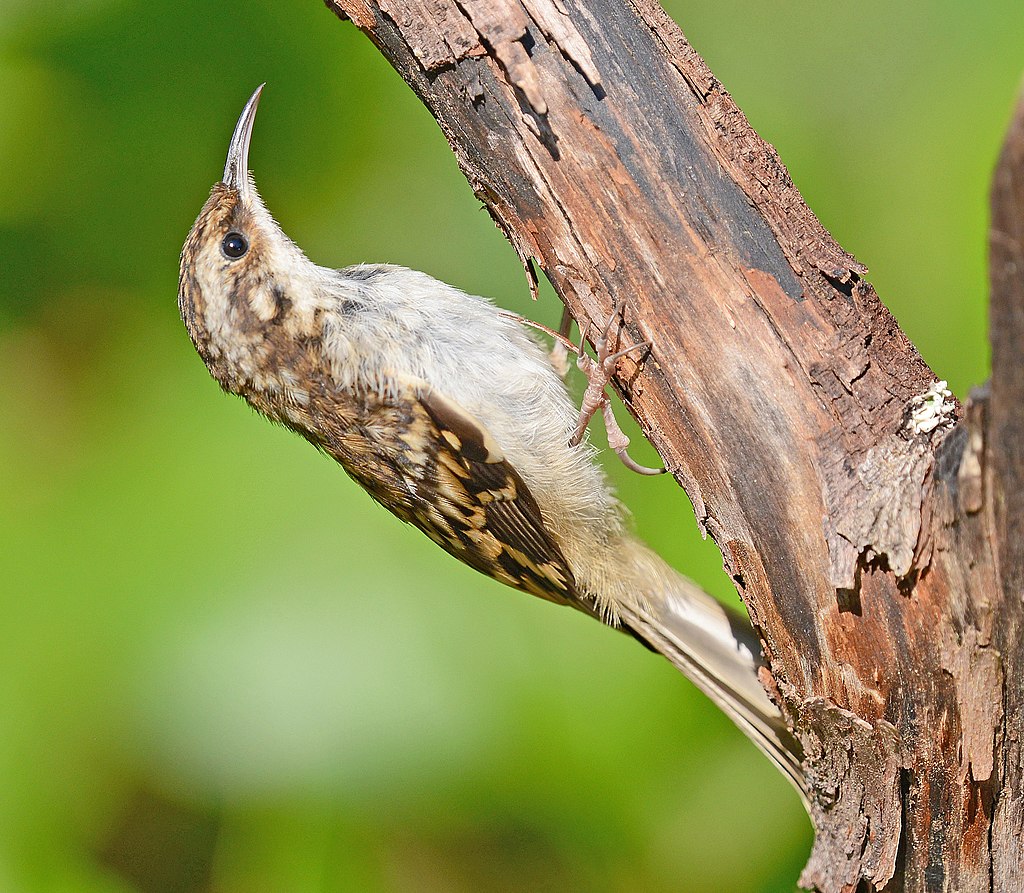
Coloration and Markings: Brown Creepers have a wild look to them, with their upper bodies being brown with streaking of white and tan. They have medium-length streaked wings and long, solid colored tails which are spine-tipped and typically dark on top and a light tan on the underside. The rump, underbelly, and breast of this bird are all white and facially, the white carries up to the throat and chin and extends back underneath the cheek. Above the white you will see a tan eyeline present while the rest of the head is brown and white streaked. Once you spot the bird next to some tree-bark the pattern design becomes crystal clear. These birds have long, thin dark bills that curve lightly downward.
Size: These birds measure in at 4.7 – 5.5 inches in length and have wingspans of 6.7 to 7.9 inches wide.
Habitat: Brown Creepers like to spend the warmer months in older evergreen forests but if they can’t find them, then evergreen and deciduous mixed woods work out just fine. In the winter they aren’t so picky at all and you can find them in just about any type of woods but deciduous areas will be the most likely place to find them at this time.
Diet: While they mostly eat insects, they are partial to cracked corn, Nyjer thistle, and even peanut butter!
Pygmy Nuthatch – Sitta pygmaea

Coloration and Markings: The Pygmy Nuthatch has a bluish-gray back with short, broad blue-gray winds and a short, squared tail of the same color. The underbelly and breast of this bird are a mix minute whites and grays with a heavy dollop of buffy tan color. This color continues up until the throat, where it changes to white, which terminate in a straight line from cheek to lower bill. The remainder of the bird’s head is a bluish gray to dark gray, with a dim, black eyestripe visible on some birds. These birds have straight, medium-length, and somewhat pointy gray and black bills, with black typically being heaviest towards the tips.
Size: These little cuties measure in at 3.5 – 4.3 inches in length and have wingspans of approximately 7.75 inches in width.
Habitat: These are birds of the ponderosa pines and they may be found at lower elevations or even as high at 10,000 feet! They do range out from time to time, but feeder visits are uncommon.
Diet: Nyjer thistle and mealworms, be they dried or live, are the best lures for tempting a Pygmy Nuthatch to your backyard feeder for a closer look.
Nevada Bird Buffet
When you want to make the perfect feeder for the local birds of Nevada it never hurts to see if there might be a little useful advice out there. Today we are sharing some tips from Birdzilla from their article “Nevada Birdwatching and Feeding Information” and we’re going to share a few of our own tips as well. Should you like to read the original article, just take a look in our reference section when you’ve finished this one and you can find a link waiting for you there. In the meantime, consider adding one or more of these foods to your feeder to up your game a little:
- Peanut butter mixed with suet
- Black Oil Sunflower
- Water-softened raisins
- Grape jelly
- Dried assorted fruits and nuts (no salt!)
Nevada Birding Hot Spots
When you want to photo or even glimpse the winged celebrities of Nevada it helps to think like a Chirparazzi. The secret is knowing where these winged-wonders will be spending their time and to that effect we’ve got a list of hotspots from all over the state of Nevada. Be sure to visit one or more when you get the chance as there is nothing quite like a snapshot of a rarely-seen bird taken in an amazing setting. Without further ado, here are our hotspots:
- Northern hotspot – Pyramid Lake
- Eastern hotspot – Stillwater National Wildlife Refuge
- Southern hotspot – Carson Valley
- Western hotspot – Sierra Valley and Yuba Pass
- Central hotspot – Virginia Lake
Detailed descriptions of each location as well as information regarding visiting and what birds you can see at these locations may be found at: https://www.nevadaaudubon.org/area-birding-guide.html
In Conclusion
Today we have discussed the popular backyard birds of Nevada and with so many to choose from we’d have to admit that we’ve barely skimmed the surface! With so many beautiful environments, the Sagebrush state should keep local birders busy for a long, long time. Color us envious, Nevada birders, and we wish you our very best. Happy birding!
